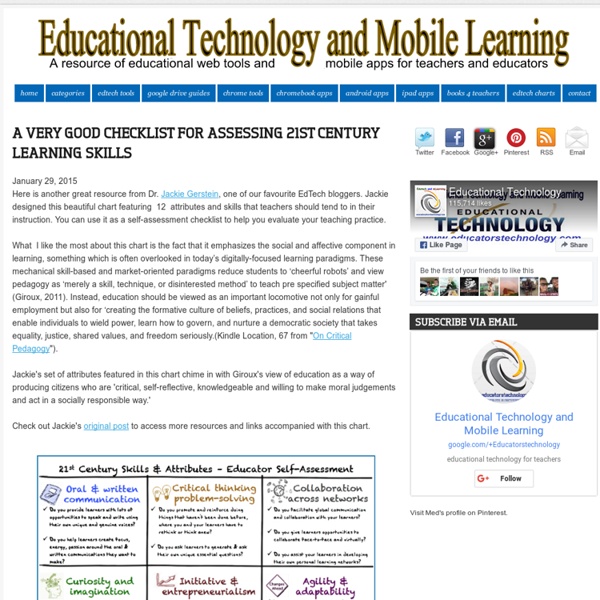The Four Most Desirable Leadership Competencies
In over 60 searches for top executives, we’ve been asked to look for the same core competencies again and again; relationship building, strategic thinking, and communication. Other requirements change from search to search, but these four competencies are so consistent that they seem to be almost universal. Whether you’re looking to hone your own leadership skills or starting out an executive search, these competencies are a good place to start. 1) Integrity Integrity permeates every aspect of a leader’s universe – every decision, relationship and action should be guided by ethics and company values.
The Other 21st Century Skills: Educator Self-Assessment
Chartkamp–I think I understand what you are saying, but in any scenario, someone, or something will spur the impetus for learning to occur. We could have a toddler go about and learn the world from scratch, but I don’t think anyone would say that is as efficient and as effective as a “parent” facilitating, or at least providing for a safe environment. And the better the parent, the more effective the toddler will be at contributing to the learning within the community as he/she progresses. Can you describe what you mean by informal learning?
Math Survey – Students
I am taking Justin Lanier’s call to action from his talk “Beyond Beauty” at the Global Math Department. I posted over the weekend about the results of my survey of teachers and staff at my school. Today, I gave it to my students. The survey looked like this: Here’s what my students said: Not subtle, huh?
Marzano's 9 Instructional Strategies In Infographic Form
Marzano’s 9 Instructional Strategies In Infographic Form by TeachThought Staff In education, louder than the call for innovation, engagement, thought, or self-direction is the call to be research-based.
The Skills Leaders Need at Every Level
A few weeks ago, we were asked to analyze a competency model for leadership development that a client had created. It was based on the idea that at different points in their development, potential leaders need to focus on excelling at different skills. For example, in their model they proposed that a lower-level manager should focus on driving for results while top executives should focus on developing a strategic perspective. Intuitively, this makes sense, based as it is on the assumption that once people develop a skill, they will continue to exercise it.
Examples of learning intentions
The learning intention is expressed in terms of knowledge, understanding and skills, and links directly with the relevant curriculum document. The design of learning intentions starts with the answers to these questions. What do I want students to know?
6 Reasons to Try a Single-Point Rubric
As educators, we know the power of a good rubric. Well-crafted rubrics facilitate clear and meaningful communication with our students and help keep us accountable and consistent in our grading. They’re important and meaningful classroom tools. Usually when we talk about rubrics, we’re referring to either a holistic or an analytic rubric, even if we aren’t entirely familiar with those terms. A holistic rubric breaks an assignment down into general levels at which a student can perform, assigning an overall grade for each level.
Mr. B's Blog: I Volunteer as Tribute: The Final HSCN
The arena set, the districts formed, the Capitol ready. Sounds like the beginning of the Hunger Games, doesn't it? This was the staging for the final HSCN: The Math Hunger Games. To bring you up to speed if you are not familiar with my HSCN, I hosted evenings three times a month where I instructed parents on math and reading. This is explored more in depth in this blog post.
126 Bloom's Taxonomy Verbs For Digital Learning -
by TeachThought Staff You can get a ready-for-the-classroom version of Bloom’s Digital Taxonomy for $6.95. At TeachThought, we’re enthusiastic supporters of any learning taxonomy. (We even created our own, the TeachThought Learning Taxonomy.) Put simply, learning taxonomies help us think about how learning happens. Even if they’re ‘not good’ as we’ve often seen the DOK framework described, they still highlight that there are many ways to frame thinking and give us practice in realizing that potential.
Developing a Competency Framework - Learning Skills from MindTools.com
Linking Company Objectives and Personal Performance © VeerBinkski Objectives should align across the oganization. You're probably familiar with the phrase ‘what gets measured gets done.'
5 Practical Techniques for Embedding Formative Assessment – LSI: LeadingEd
By Dr. Dylan Wiliam Embedding Formative Assessment, which I wrote with Siobhán Leahy, is designed specifically to help individual teachers develop their practice of formative assessment on their own or with small groups of colleagues. Here are some suggestions for practical techniques you can try in your classroom right now.


